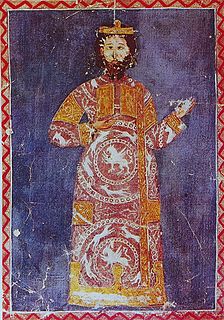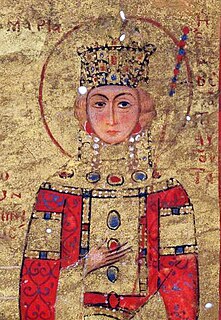 W
WAlexios V Doukas, in Latinised spelling Alexius V Ducas, was Byzantine emperor from 5 February to 12 April 1204, just prior to the sack of Constantinople by the participants of the Fourth Crusade. His family name was Doukas, but he was also known by the nickname Mourtzouphlos or Murtzuphlus (Μούρτζουφλος), referring to either bushy, overhanging eyebrows or a sullen, gloomy character. He achieved power through a palace coup, killing his predecessors in the process. Though he made vigorous attempts to defend Constantinople from the crusader army, his military efforts proved ineffective. His actions won the support of the mass of the populace, but he alienated the elite of the city. Following the fall, sack, and occupation of the city, Alexios V was blinded by another ex-emperor and later executed by the new Latin regime. He was the last Byzantine emperor to rule in Constantinople until the Byzantine recapture of Constantinople in 1261.
 W
WTheodora Angelina was the wife of Leopold VI of Austria, by whom she had several children.
 W
WAlexios IV Angelos or Alexius IV Angelus was Byzantine Emperor from August 1203 to January 1204. He was the son of Emperor Isaac II Angelos and his first wife, an unknown Palaiologina, who became a nun with the name Irene. His paternal uncle was his predecessor Emperor Alexios III Angelos.
 W
WNiketas or Nicetas Choniates, whose actual surname was Akominatos (Ἀκομινάτος), was a Greek Byzantine government official and historian – like his brother Michael Akominatos, whom he accompanied to Constantinople from their birthplace Chonae. Nicetas wrote a history of the Eastern Roman Empire from 1118 to 1207.
 W
WGeorge Palaiologos Doukas Komnenos was a high-ranking Byzantine aristocrat and diplomat of the 12th century. A kinsman of the ruling Komnenos dynasty, George Palaiologos held the rank of sebastos and the office of megas hetaireiarches. His son Alexios was briefly heir-apparent to Emperor Alexios III Angelos, and his great-grandson Michael VIII Palaiologos founded the Palaiologan dynasty of Byzantine emperors.
 W
WStephen Hagiochristophorites was the most powerful member of the court of Byzantine emperor Andronikos I Komnenos. His end came while trying to arrest Isaac II Angelos, who killed Stephen and, the next day, deposed and replaced Andronikos.
 W
WSaint Irene of Hungary, born Piroska, was a Byzantine empress by marriage to John II Komnenos. She is venerated as a saint.
 W
WGregory Kamateros was a senior Byzantine official. Of low birth but very well educated, he reached high office under Emperor Alexios I Komnenos and eventually became logothetes ton sekreton, de facto prime minister, under both Alexios and John II Komnenos. Through his marriage with Irene Doukaina, an imperial relative, he founded the bureaucratic dynasty of the Doukai–Kamateroi.
 W
WConstantine Euphorbenos Katakalon was a Byzantine noble and one of the most prominent generals of the reign of Alexios I Komnenos.
 W
WThe Kokkinobaphos Master is the conventional name by which modern historians call a master miniaturist active in Constantinople, the capital of the Byzantine Empire, during the 12th century.
 W
WAnna Komnene, commonly Latinized as Anna Comnena, was a Byzantine princess and author of the Alexiad, an account of the reign of her father, the Byzantine emperor, Alexios I Komnenos. The Alexiad is the most important primary source of Byzantine history of the late 11th and early 12th centuries. Although she is best known as the author of the Alexiad, Anna played an important part in the politics of the time and attempted to depose her brother, John II Komnenos, as emperor and seize the throne herself.
 W
WMaria Komnene or Comnena was the second wife of King Amalric I of Jerusalem and mother of Queen Isabella I of Jerusalem.
 W
WTheodora Komnene, Latinized Theodora Comnena, was a daughter of the Byzantine prince Andronikos Komnenos and his wife, Eirene (?Aineiadissa). Based on the writings of Niketas Choniates, it is likely Theodora was Andronikos' second daughter. The year of Theodora's birth is unknown.
 W
WTheodora Komnene or Comnena was a niece of Byzantine emperor Manuel I Comnenus, and wife of King Baldwin III of Jerusalem.
 W
WAlexios Komnenos was a Byzantine aristocrat and courtier. A son of Andronikos Komnenos and nephew of Emperor Manuel I Komnenos, he rose to the high rank of prōtostratōr in 1167. In 1176 he participated in the Myriokephalon campaign where, following the death of his older brother John, he was raised to the titles of prōtosebastos and prōtovestiarios. Following Manuel's death in 1180, he won the favour, and reportedly became the lover, of Empress-dowager Maria of Antioch. Through her he ruled the Byzantine Empire for two years as de facto regent of the underage emperor Alexios II Komnenos. The aristocracy challenged his dominance, led by the princess Maria Komnene, who plotted to assassinate the prōtosebastos. The plot was discovered and most conspirators arrested, but Maria and her husband fled to the Hagia Sophia, protected by Patriarch Theodosios Borradiotes and the common people of Constantinople.
 W
WConstantine Komnenos was a Byzantine aristocrat and nephew of Emperor Alexios I Komnenos. Promoted to the rank of sebastos, he served as doux of Beroea in 1107, and later as megas droungarios. He married a lady issued from the Antiochos and Euphorbenos clans.
 W
WIsaac Komnenos or Comnenus was a notable Byzantine aristocrat and military commander in the 1070s. Isaac played a major role in the rise to the throne of his younger brother, the Byzantine Emperor Alexios I Komnenos, and remained a leading figure in his brother's administration until his death.
 W
WIsaac Komnenos or Comnenus was the third son of Byzantine Emperor Alexios I Komnenos and Empress Irene Doukaina. He was raised to the high rank of sebastokrator by his older brother John II Komnenos in reward for his support, but they later fell out, as Isaac began to covet the throne.
 W
WIsaac Doukas Komnenos was a claimant to the Byzantine Empire and the ruler of Cyprus from 1184 to 1191. Contemporary sources commonly call him the Emperor of Cyprus. He lost his empire to Richard the Lionheart during the Third Crusade.
 W
WConstantine Manasses was a Byzantine chronicler who flourished in the 12th century during the reign of Manuel I Komnenos (1143-1180). He was the author of a chronicle or historical synopsis of events from the creation of the world to the end of the reign of Nikephoros Botaneiates (1081), sponsored by Irene Komnene, the emperor's sister-in-law. It consists of about 7000 lines in political verse. It obtained great popularity and appeared in a free prose translation; it was also translated into Bulgarian in the 14th century.
 W
WTheodore Mangaphas or Mankaphas was a nobleman from Philadelphia who assumed the title of Byzantine emperor twice, first during the reign of Isaac II Angelos, and secondly after the sacking of Constantinople during the Fourth Crusade.
 W
WMaria of Antioch (1145–1182) was a Byzantine empress by marriage to Byzantine Emperor Manuel I Komnenos, and regent during the minority of her son porphyrogennetos Alexios II Komnenos from 1180 until 1182.
 W
WMichael I Komnenos Doukas, Latinized as Comnenus Ducas, and in modern sources often recorded as Michael I Angelos, a name he never used, was the founder and first ruler of the Despotate of Epirus from c. 1205 until his assassination in 1214/15.
 W
WLeo Sgouros, Latinized as Leo Sgurus, was a Greek independent lord in the northeastern Peloponnese in the early 13th century. The scion of the magnate Sgouros family, he succeeded his father as hereditary lord in the region of Nauplia. Taking advantage of the disruption caused by the Fourth Crusade, he made himself independent, one of several local rulers that appeared throughout the Byzantine Empire during the final years of the Angeloi dynasty. He expanded his domain into Corinthia and Central Greece, eventually marrying the daughter of former Byzantine emperor Alexios III Angelos. His conquests, however, were short-lived, as the Crusaders forced him back into the Peloponnese. Blockaded in his stronghold on the Acrocorinth, he committed suicide in 1208.
 W
WTheodore II Eirenikos, , also known as Theodore Kopas or Koupas (Κωπάς/Κουπάς), was a high-ranking Byzantine official and chief minister during most of the reign of the Byzantine emperor Alexios III Angelos. After the fall of Constantinople to the Fourth Crusade, he fled to the Empire of Nicaea, where he became a monk and served as Patriarch of Constantinople in exile in 1214–1216.
 W
WBasil Vatatzes was a Byzantine military commander, and likely the father of the Nicaean emperor John III Doukas Vatatzes.